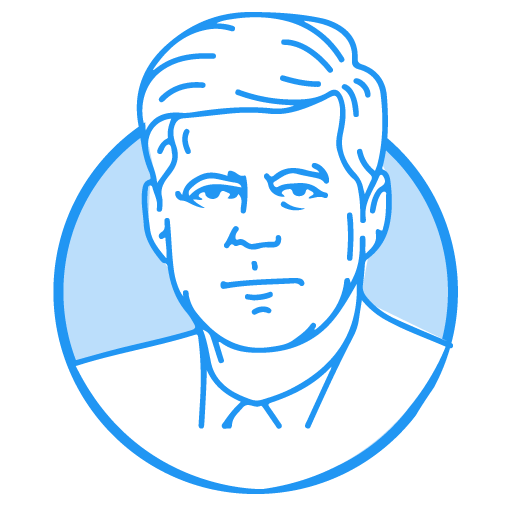What is Organizational Learning and why is it important?
“In less than 15 years, one-third of the fortune 500 companies have disappeared, and the average lifetime for the largest enterprises is less than 40 years.” This was a shocking observation by Peter M. Senge, the MIT professor who coined the term “Learning Organization”. He was named as “strategist of the century” by the Journal of Business Strategy.
So how can companies that excelled their way to the top suddenly plunge? And on the contrary, how do other companies manage to stay consistently at the top?
Leadership and learning are indispensable to each other
The answer to the puzzle is that the companies that endured have succeeded somewhat in creating a “Learning Organization”
According to Peter M. Senge “a learning organization is a group of people working together collectively to enhance their capacities to create results they really care about.”
Five elements of Learning Organization:
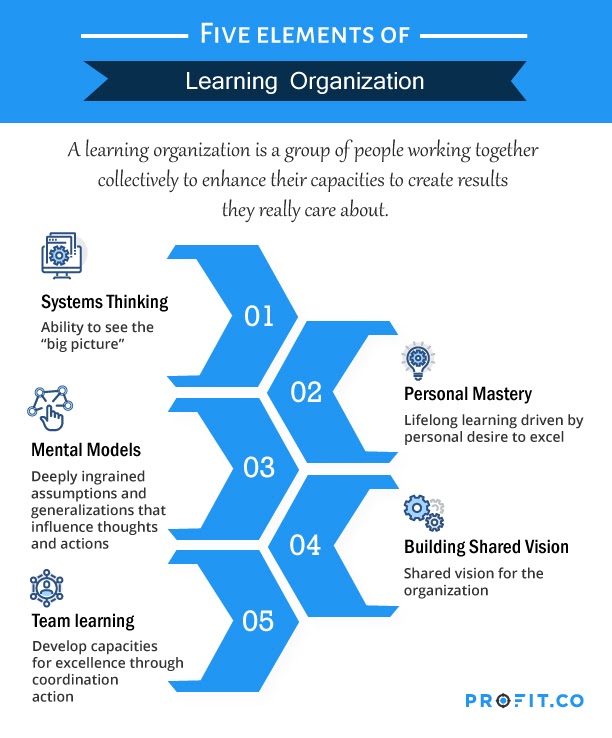
Systems Thinking:
Systems thinking is about thinking and visualizing the system as a whole, instead of focusing on individual issues, i.e. Ability to see the “big picture”. In many cases the correlation between action and consequences may occur in different time spans. Example, if a company decides to cut their R&D budget, while they may increase their profit in the short term, in the long-term they may be causing irreparable harm to the competitiveness of the firm.
Personal Mastery:
Peter M. Senge refers to Personal Mastery as an approach towards a skill or craft as to how master artists would view their art – They are committed to lifelong learning and work till they can consistently achieve results that would deeply matter to them. An organization’s learning “capacity and commitment” cannot be greater than that of it’s members. Hence the connection between “Personal learning” and “Organizational learning” is vital. Organizations need to create a culture that values Personal Mastery and provides the enabling tools and environment for the same.
Mental Models:
According to Peter M. Senge, Mental models are deeply ingrained assumptions and generalizations that influence how we understand the world and how we take action. Very often, we are not consciously aware of our mental models or the effects they have on our behaviour. For example, we may observe a “quiet person “who seldom talks in meetings and say to ourselves, “This person doesn’t seem to understand what is being discussed”. About someone who “forcefully makes her points in meetings”, we may feel that “This person wants to dominate the meeting”. Mental models of what can or cannot be done in different management settings can also be deeply entrenched. Many new insights are “brushed aside” as they may conflict with powerful, existing mental models. For example, “Emerging markets are difficult to crack” may be the: mental model” of an executive who may hence fail to allocate resources to potentially attractive markets early enough and hence lose out to competition in the long-run.
Building Shared Vision:
One of the key qualities of leadership is the ability to create a “shared vision” for the organization – a “shared picture of the future, that the organization will create”. For example, in the case of Tesla – “To accelerate the world’s transition to sustainable energy”, LinkedIn – “To connect the world’s professionals to make them more productive and successful.”, Amazon – “To be Earth’s most customer-centric company, where customers can find and discover anything they might want to buy online, and endeavors to offer its customers the lowest possible prices.” Converting the personal vision of a leader to the shared vision of an organization is a crucial challenge and great organizations that survive the transition of leadership from a charismatic founder need to find a way to achieve the same.
Team learning:
In sports, business, Science and in other aspects of life too we have seen teams without a “complete roster of star players” still excelling in performance by “developing capacities for excellence through coordinated action” – The San Antonio Spurs in NBA is a good example. Peter M. Senge also observes that teams when they are truly learning not only produce extraordinary results but also results in “individuals growing more rapidly than would have occurred otherwise”. The first step for Team Learning to happen are Dialogues – the capacity of team members to “suspend assumptions’ and enter into genuine “Thinking together”.
Live as if you were to die tomorrow. Learn as if you were to live forever.
When people join the workforce fresh after college, most enter with great enthusiasm looking forward to a lifetime of learning and working with purpose. But few organizations have a culture that encourages risk-taking, experimentation, continuous learning and tolerate failure. But with rapid changes happening in the business environment through factors like ubiquitous broadband, digitization and changing customer preferences and overall raising of bar in every sphere of business, Organizations that do not institutionalize learning can quickly lose ground and become obsolete as they will lack the agility required to respond to changes unleashed by the environment or by a plucky competitor.
Tell me and I forget, teach me and I may remember, involve me and I learn.
Culture -The enabling factor for Learning:
It is the responsibility of the leadership team to create an enabling environment for learning. Following are the key methods to create and nurture a high-performance culture for a great learning environment.
- Start with the Why: Leaders should be able to clearly define the Purpose and Mission of the organization. This helps the various teams to set their Learning priorities.
- Set the bar High: Leadership should set the bar high for their teams. This should happen in every phase of the OKR cycle. Stretch targets help Learning. Also review of deliverables should also reinforce the message of high standards
- Provide Quick Feedback: Quick feedback to team members should be encouraged. This improves the agility of the organization and motivates team members to share early and frequently.
- Encourage experimentation: This is the opposite of Business As usual. Learning Organizations encourage experimentation, tolerate failures and encourage curiosity
- Celebrate wins: Even small wins need to be celebrated. Today’s digital organizations usually have tools that encourage collaboration and have internal social networks that can be easily used to recognize great contributors and celebrate wins.
- Promote Transparency: OKRs of all the teams should be default set to be visible to everyone else.
- Leaders as Coaches: Leaders should adopt the style of coaches, setting high but achievable goals, provide straight and early feedback and encourage team members to excel.
- Have a Growth Mindset: According to Carol Dweck who coined the term “Growth Mindset“ Individuals who believe their talents can be developed (through hard work, good strategies, and input from others) have a growth mindset. They tend to achieve more than those with a more fixed mindset (those who believe their talents are innate gifts). This is because they worry less about looking smart and they put more energy into learning. When entire companies embrace a growth mindset, their employees report feeling far more empowered and committed”
- Reward sharing: People learn more by Teaching. Reward sharers and discourage hoarders.
- Don’t start from Zero: If organizations can institutionalize learning then people will have access to knowledge repositories and will be able to improve productivity by building on the Learning from others. Leadership should watch for “reinventing the wheel” by discouraging people” starting from Zero”
Anyone who stops learning is old, whether at twenty or eighty. Anyone who keeps learning stays young.
PEEL Methodology – learning in every phase of the OKR Lifecycle
Defining a clear execution methodology like PEEL and baking in Learning as part of the process to execute strategy is a great way to institutionalize learning.
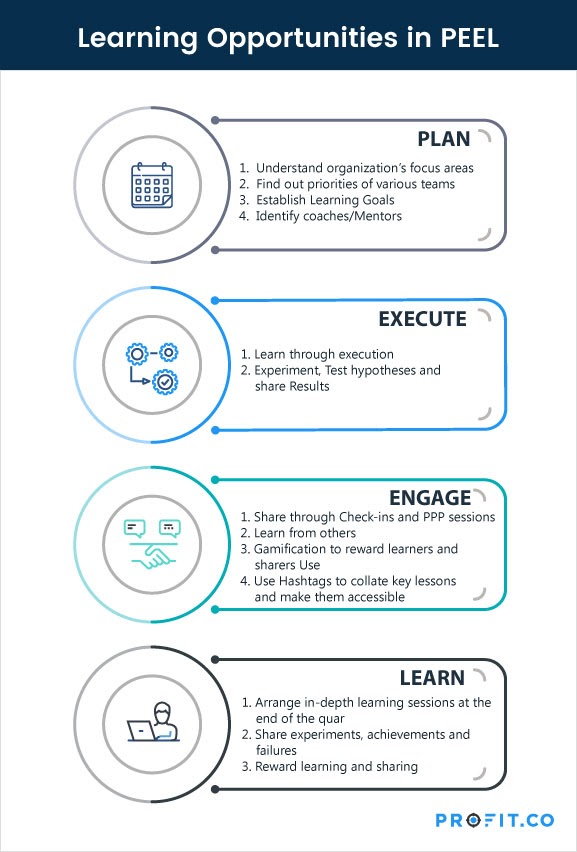
Plan:
Leaders and teams will choose 3 to 5 objectives that are crucial to the organization for the quarter/year. This gives clarity to the people on the areas they need to focus to learn. It also helps the various departments to align and plan their learning efforts as well. For example, let us say a tech company chooses an objective as Improve Sales Efficiency for the quarter and the Key Result: Improve Trial to closure from 10% to 25%.
This OKR results in the following Learning objectives for the various departments:
Sales: To close more deals, the sales team needs to work on Demo skills, Customer Engagement & Closing skills
Marketing: Generating high-quality leads (trial customers) requires better Digital Marketing skills
Product: Improving usability and features to accelerate adoption requires better design and engineering skills
Customer Experience: Improving Customer Engagement requires skills for mapping customer journeys and design skills to create a great customer experience
Thus the learning goals derive from the OKRs and leadership can encourage people by setting ambitious, yet achievable goals.
The PLAN phase is an opportunity for the entire organization to learn the key focus areas for the organizations. And ensure that the team is clear about the overarching goals. This is an achievement by itself for the leadership as studies have pointed out that in a typical organization up to 95% of the employees are not even aware of the organization’s strategy.
Execute:
Iterative Business execution is the agile way to quickly experiment approaches for solving challenging problems. We had looked at the Key Result, Improve Trial to closure from 10% to 25%. The Product and Customer Experience teams will collaborate and experiment multiple options to help users achieve their goals by tweaking the design. By measuring the completion of tasks by customers and their engagement with the product there is significant learning for the organization. For example one of the SaaS organizations found through experimentation that certain personas like CEOs preferred less options and a template based approach that would help them to complete their tasks quickly.
Thus during execution, various departments and teams learn valuable lessons on the approaches to solve problems and achieve their Key Results. One marketing team wanted to experiment with display ads in an industry portal targeting sourcing professionals. They tried multiple types of display ads and learnt that the click through rate was low. But when they tweaked the ads showing the value proposition in “numbers” instead of just the usual “catchy slogans” they found that the click through rate improved. Still they found that other marketing options were performing better and they dropped the display ads after the first month. The OKR tool used helped them to record their lessons learned during their weekly check-ins and they used intuitive hashtags like #Marketing Lessons, so that even in the future, people can continue to learn from their experiments.
Engage:
The OKR Cycle requires teams to do weekly check-ins. The PPP reviews that follow may be great moments for the leadership and teams to engage by sharing their approaches and experiments and giving constructive feedback and even asking for help from other teams. We have found that Gamification works when it comes to Learning. Giving reward Points for people who contribute frequently to the knowledge repositories and those who answer queries of team members frequently, encourages everyone to share more. Hashtags can also be used creatively to collate Lessons Learned in a particular area, Eg. #Closing Techniques, #Objection Handling, #Userpersona, #LoadingTime
Learn:
During the final week of the quarter, Reflect/Reset happens. We encourage organizations to have detailed sessions specifically on their Lessons Learned during the quarter. This is a great opportunity for various teams to understand each other’s approaches, experiments and achievements (and also failures). Leadership should use this as an opportunity to reward the teams and individuals who excelled in learning a well as those who excelled in sharing (ie. Teaching).
Tools and Infrastructure for Learning:
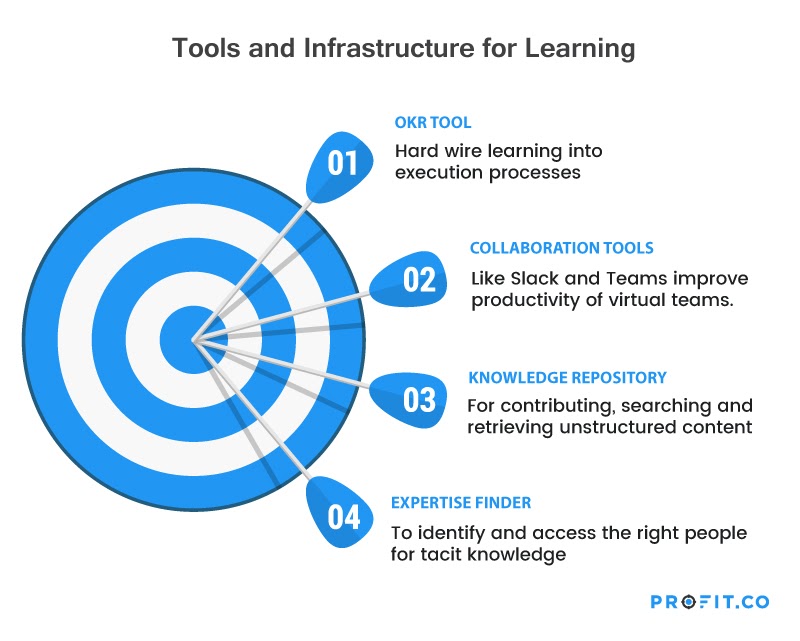
OKR Software:
A great OKR software like Profit.co would help teams to hardwire learning into their execution processes. They will be able to record their learning during every phase, use hashtags to engage team members and record their lessons learned in the repository. A good OKR tool will also have gamification features that will encourage and award the greatest contributors to organizational Learning.
Collaboration Tools:
Collaboration tools like Slack and Microsoft teams do help teams to share their tacit knowledge. Virtual teams absolutely require these tools to improve productivity and learn from each other.
Knowledge Repository:
Now Having a good knowledge repository that can manage unstructured content will be a great asset for building learning organizations. They should provide the ability for people to easily contribute content, tag for easy retrieval, an intuitive user interface and a helpful search feature for easy accessibility. Organizations like McKinsey are known to have great repositories that help learning and improve productivity.
Expertise Finder:
Knowledge can be classified into types: One, Explicit Knowledge that can be codified and captured in content repositories. Two, Tacit Knowledge, ie. Knowledge that exists in the brains of people which is implicit and difficult to codify and document. Expertise Finder Directories help organizations to organize the experts in various skills through directories that are connected to the collaboration systems helping people to search and find the right go-to people. Universities and Consulting organizations (learning organizations, for sure) are known to have excellent expertise finders.
Learning & the Quarterly Calendar:
In the OKR calendar, we have indicated that the 3rd Wednesday of the month to be dedicated for learning through brown bag sessions and the last Wednesday of the quarter to be dedicated for a town hall session to celebrate Learning throughout the quarter. But the OKR cycle provides more learning opportunities during weekly PPP reviews to share learning. We encourage teams to have at least one Team huddle/week to share Learning. Also Check-ins should include the Lessons learned during the week.
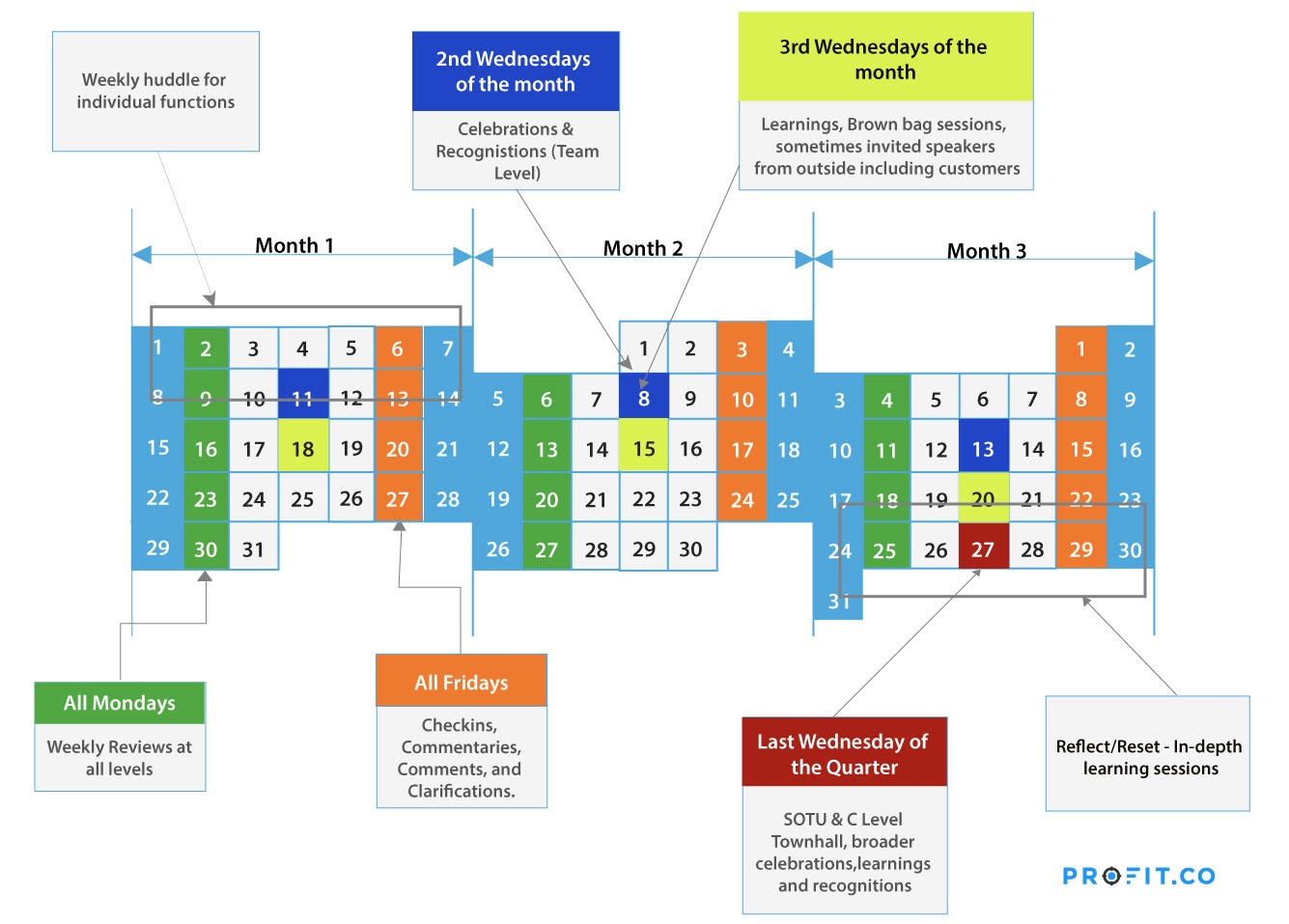
10 Steps to Institutionalize Learning:
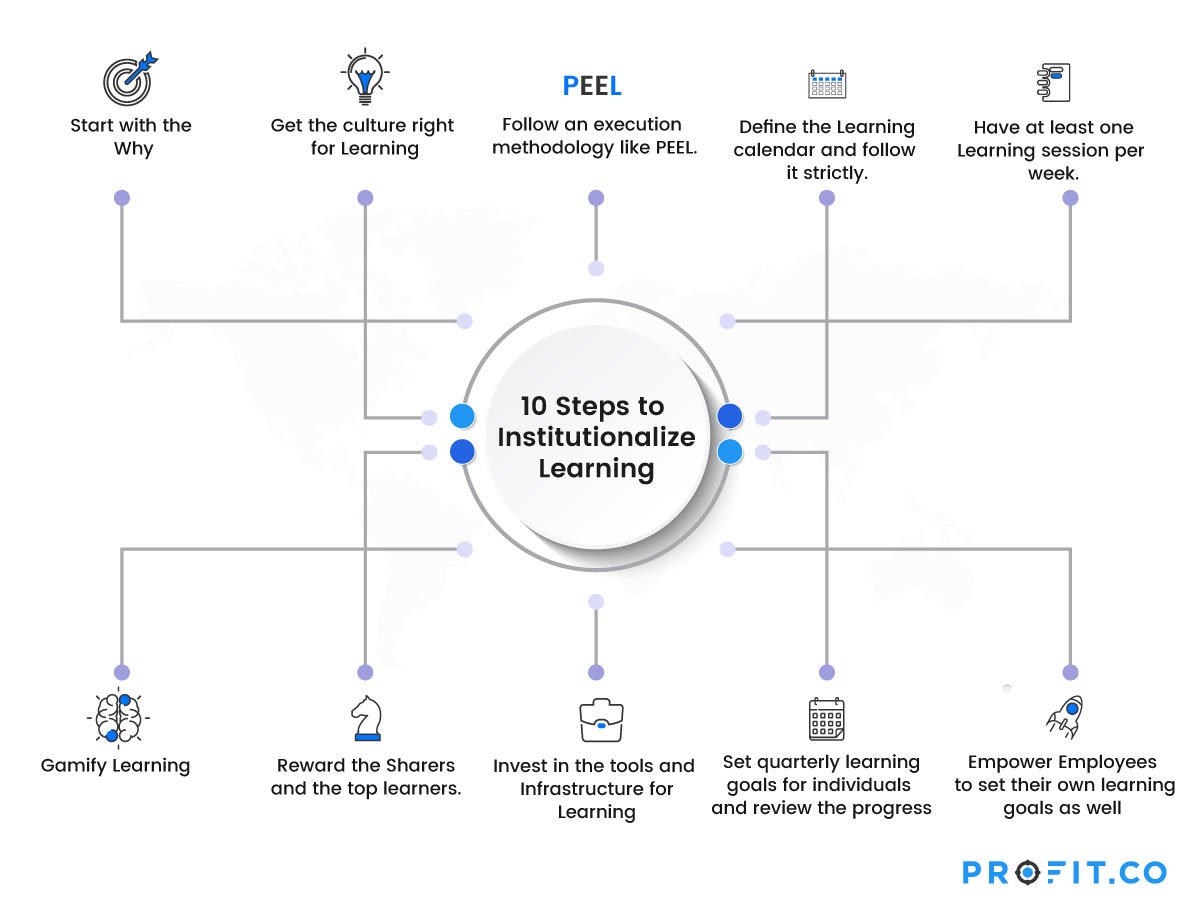
- Start with the Why: Leaders should define the Purpose and Mission of the organization. This helps team members to set their Learning priorities.
- Get the culture right for Learning
- Follow an execution methodology like PEEL that bakes Learning into the execution process.
- Define the Learning calendar (quarterly) and follow it strictly.
- Have at least one Learning session per week.
- Gamify Learning (measure).
- Reward the Sharers and the top learners.
- Invest in the tools and Infrastructure for Learning
- Set quarterly learning goals for individuals and review the progress
- Empower Employees to set their own learning goals as well
Ready to start your OKR Journey for FREE?

